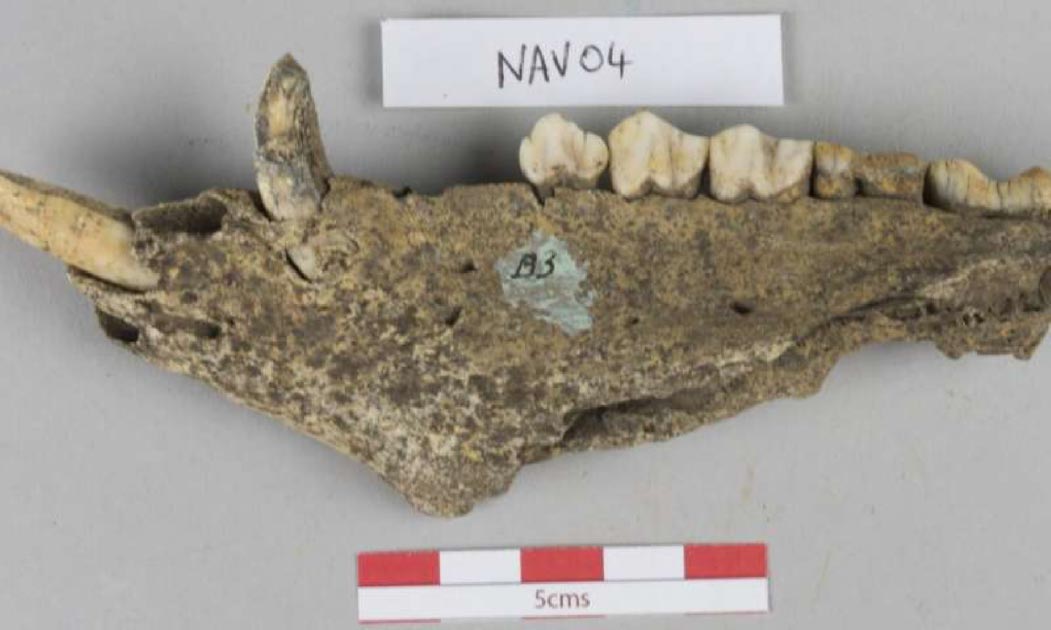Iron Age Feasting and Festivities Evidenced at Navan Hill Fort
Animal teeth and bones excavated by archaeologists from the ancient Navan Hill Fort site in modern-day County Armagh suggest the location was an ancient center for ritual gatherings.
Each of the pig, cow and sheep bones were uncovered from the 2500-year-old fort located in the ancient capital of Ulster and the scientists have determined that large feasts drew crowds from across Ireland in the Iron Age, with ´chemical fingerprints´ revealing that the bones came from more than 100 miles away.
In a new scientific paper published in the journal Scientific Reports the results of a new technique called multi-isotope analysis, which was applied to the samples of animal bones and tooth enamel, revealed the origins of each slaughtered animal and add to our understanding of a period of British history just before the Romans arrived.

Navan Hill Fort, County Armagh, Heading north-east to the top of the mound. (© Kenneth Allen / CC BY-SA 2.0)
Pigs And Monkey Bones In Ancient Ireland
Over 2,500 years ago, party animals brought animals more than 100 miles (161 kilometers) to slaughter ritually for large scale community feasts at the fort located in one of the traditional counties of Ireland and one of six counties that form Northern Ireland. Markers found in bone samples indicated the animals came from as far afield as Antrim, Donegal, Down, Galway and Tyrone to the ancient Navan Hill Fort and a team of archaeologists led by Dr Richard Madgwick of Cardiff University analyzed 35 animal bones revealing a high proportion of pig remains which are ´very rare for this period.´
The bone analysis reveals the sheer scale of cultural interaction and mobility during this mysterious period of which so little is known, and these new discoveries at Navan Fort suggest the location was a center for feasting on pigs which historical Irish records say was the preferred ancient food for feasts. A PHYS.org article says historians believe this 135 feet (40 meters) wide round fort may have been the residence a king, chieftain or druid, indicated by the recovery of a Barbary ape brought there from Spain, Portugal or maybe North Africa.

The Barbary ape would have been imported from a great distance. (CC0)
Multi-isotope Analysis Is All The Rage These Days
The multi-isotope analysis revealed the chemical compositions of the animal bones and particularly the teeth, which are chemically linked to the geographical areas from which the animals eat and drank. These chemical signals allowed scientists to determine the location in which each animal was raised and Dr Madgwick said Navan Fort had a ´vast catchment´ and that the influence of the site was ´far-reaching.’
According to one of the paper's authors, Belfast archaeologist Finbar McCormick, considering the absence of human remains these new multi-isotope analyses of animal teeth and bones provides archaeologists with “the best indication of human movement at that time.”
Feasting, was in ancient times associated with sacrifice and only in March this year I wrote an Ancient Origins news piece about another paper published by Dr Madgwick who this time analysed ´131 pig remains found at sites around Stonehenge´ that revealed they had been brought there from as far away as Scotland.
- Rebel Judge and Executioner? The Brutal Cromwellian Conquest of Ireland
- Vikings in Ireland: Traces of Warriors Not Just Buried Beneath the Ground, They Are in the DNA
- Quaffing Here For 11 Centuries: Sean’s Bar Claims Title of Oldest Pub in Ireland, Europe and Possibly the World

The analysis shows people and goods came from far and wide for feasts at Navan Hill Fort. (Public Domain)
Fattened For The Slaughter
Transporting live animals, especially pigs, across the Britain would have involved a great deal of time and considerable effort, so both the earlier March paper and these new findings not only demonstrate the important role pigs and other animals played in society, but that ´Food was clearly a central part of people's exchanges and traditions,’ said Dr Madgwick.
Ancient people travelled hundreds of kilometers across Britain and Ireland to attend great feasts and festivals at stone circles and sacred sites and according to Dr Richard Madgwick his findings demonstrate how in ancient Britain pigs were transported from as far afield as the north-east of Scotland and Ireland.
A March 2019 Live Science article quotes Dr Madgwick saying the pigs were ´coaxed to move´ and fattened up along the way before reaching their ultimate standing stone or henge destination where they were slaughtered and cooked. In conclusion, transporting pigs, whether slaughtered or walking, over hundreds of kilometers required maritime and riverine transportation ‘linking the network of sites together’ and this new study shows the same practice was being performed by prehistoric cultures in Ireland.
Top image: A pig’s jaw found at the Navan Hill Fort site Source: Dr Richard Madgwick / Scientific Reports
By Ashley Cowie
References
Madgwick, R., Grimes, V., Lamb, A.L. et al. Feasting and Mobility in Iron Age Ireland: Multi-isotope analysis reveals the vast catchment of Navan Fort, Ulster. Sci Rep 9, 19792 (2019) https://doi.org/10.1038/s41598-019-55671-0



















